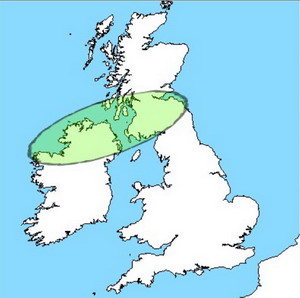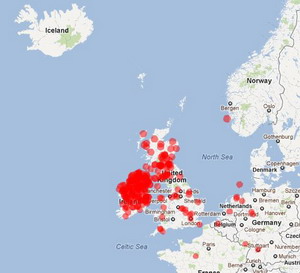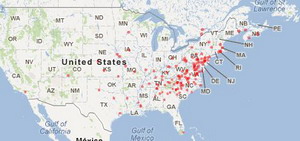BAMAD. |
BAMAD-104
Brit-Am Anthropology and DNA Update
7 March 2012, 13 Adar 5772
Contents:
1. Racial Origins of the Population of Turkey.
Turkish population structure (Hodo
lugil and Mahley, 2012)
2. Neil in North America (Appalachians) and Amongst the Scottish.
3. R1b from Western Asia i.e. Syria, Lebanon, Israel, and Turkey.
Brit-Am
Discussion Group

Contents by Subject
Research
Recognition
Reconciliation
Contribute
Site Map
Contents in Alphabetical Order

This Site
1. Racial Origins of the Population of
Turkey.
Turkish population structure (Hodo lugil
and Mahley, 2012)
http://dienekes.blogspot.com/
Extracts:
These results appear to be consistent with my own estimate of 1/7 Central
Asian ancestry for Anatolian Turks. In a more recent analysis based on haplotype
sharing, I have discovered that there is some sub-structure within the Turkish
population, with the emergence of three tendencies: a central group of Anatolian
Turks, a group of Turks with partial origin from the Balkans, and a group of
Turks from northeastern Anatolia. As more project participants join the Dodecad
Project, we will learn much more on the structure of the Turkish population and
its relationships with its geographical neighbors and linguistic relatives.
Annals of Human Genetics DOI: 10.1111/j.1469-1809.2011.00701.x
Turkish Population Structure and Genetic Ancestry Reveal Relatedness among
Eurasian Populations
U ur Hodo lugil, Robert W. Mahley
Turkey has experienced major population movements. Population structure and
genetic relatedness of samples from three regions of Turkey, using over 500,000
SNP genotypes, were compared together with Human Genome Diversity Panel (HGDP)
data. To obtain a more representative sampling from Central Asia, Kyrgyz samples
(Bishkek, Kyrgyzstan) were genotyped and analysed. Principal component (PC)
analysis reveals a significant overlap between Turks and Middle Easterners and a
relationship with Europeans and South and Central Asians; however, the Turkish
genetic structure is unique. FRAPPE, STRUCTURE, and phylogenetic analyses
support the PC analysis depending upon the number of parental ancestry
components chosen. For example, supervised STRUCTURE (K= 3) illustrates a
genetic ancestry for the Turks of 45% Middle Eastern (95% CI, 42'49), 40%
European (95% CI, 36'44) and 15% Central Asian (95% CI, 13'16), whereas at K= 4
the genetic ancestry of the Turks was 38% European (95% CI, 35'42), 35% Middle
Eastern (95% CI, 33'38), 18% South Asian (95% CI, 16'19) and 9% Central Asian
(95% CI, 7'11). PC analysis and FRAPPE/STRUCTURE results from three regions in
Turkey (Aydin, Istanbul and Kayseri) were superimposed, without clear
subpopulation structure, suggesting sample homogeneity. Thus, this study
demonstrates admixture of Turkish people reflecting the population migration
patterns.
2. Neil in North America (Appalachians)
and Amongst the Scottish.
R-M222 SNP Map (FTDNA)
http://clanmaclochlainn.com/R1b1c7/SNPMap.htm
Indicates a strong Scots-Irish (as well as Irish) connection
From: Lochlan@
Subject: [R-M222] M222 SNP Map
_http://clanmaclochlainn.com/R1b1c7/SNPMap.htm_



Extract:
The other thing I found interesting was the distribution of M222 in the
U.S. To my eyes the pattern seems to follow the Appalacian mountain range
which is mostly associated with the Scots-Irish.
It's easy to explain the proliferation of M222 in Ireland after 400 AD.
One only need look to the establishment of hereditary kingdoms and
chieftainships under the Ui Neill and Connachta which survived virtually intact
until 1600 AD. Why is it so heavy in the lowlands, central and eastern
portions of Scotland? I can't think of a similar situation there. In Scotland
the heaviest concentrations do not seem to be the ancient homeland of the
Irish Dal Riata. Instead it seems to be in the old territories of the
northern Britons and up into the homeland of the Picts. I'm sure modern
migration to large cities has skewed the situation somewhat.
If I'm not mistaken the territory of the Clan Donnachaidh was in the
central/eastern red areas of Scotland. And they are one of the few (actually I
think only) Scottish clan heads who tested M222 positive. Weren't many of
the Scottish Kennedys from the same general area? And the Ewings? I
can't connect this to any tribe or dynasty known in Scotland though.
John
R1b1c7 Research and Links:
http://clanmaclochlainn.com/R1b1c7/
Brit-Am Note:
We were informed by private communication that the Plantation of Protestants into Ulster included the movement of certain Gaelic clans en masse from Scotland.
These clans were descendants of the Connachta who had previously moved from Ireland to Scotland. This would explain why such a high percentage of Scotch-Irish have the same DNA as Nial and the Connachta.
3. R1b from Western Asia i.e. Syria,
Lebanon, Israel, and Turkey.
(a) Extract from Wikipedia: Western Asia
[Land of Israel Area] Origins'
Haplogroup R1b (Y-DNA)
From Wikipedia, the free encyclopedia
http://en.wikipedia.org/wiki/
Haplogroup_R1b_(Y-DNA
The point of origin of R1b is thought to lie in Eurasia, most likely in Western
Asia.[7]
(b) Questions for Conventional
Researchers.
No R1b finds from archaeological remains in western Europe have been found
before ca. 1000 BCE. Even then the finds are very sparse at first, and the
dating should probably be much later.
Researchers NOWADAYS are inclined to admit that R1b originated in the West Asian
area i.e. Syria, Lebanon, Israel, and Turkey. This is the region the Ten Tribes
came from.
The experts however put the dating and subsequent movement westward of R1b way
way back into the mists of time.
Three Possibilities Remain:
(a) It may be that later findings will reveal more early R1b DNA BUT this now
seems very unlikely.
(b) It may be necessary to countenance the ancestors of modern R1b carriers
having belonged to some other YDNA haplogroup which subsequently underwent a
change.
We personally believe this to have been a possibility BUT conventional DNA
doctrine would need too drastic a revisal for this to be considered.
(c) The date for the movement of R1b must be revised and placed much later i.e.
ca. 700 BCE which is about the time the
Ten Tribes were exiled!!!

Pleased with what you read'
The Brit-Am enterprise is a Biblical work.
God willing, they who assist Brit-Am will be blessed.
Brit-Am depends on contributions alongside purchases of our publications
Click Here to make an offering.
Click Here to view our publications.
'It is impossible to rightly govern the
world without
God or the Bible.'
George Washington
Brit-Am is the "still small voice" that contains the truth.
"after the earthquake a fire, but the LORD was not in the fire; and after the fire a still small voice"
[1-Kings 19:12].
PREVIOUS ISSUES
Security Cameras, Florida, USA.

The Lifestyle Doctor

Home
|
Brit-Am Discussion Group |
Contents by Subject |
Research Recognition Reconciliation Contribute |
|
Site Map Contents in Alphabetical Order |
This Site |
1. Racial Origins of the Population of
Turkey.
2. Neil in North America (Appalachians)
and Amongst the Scottish.
Extract:
3. R1b from Western Asia i.e. Syria,
Lebanon, Israel, and Turkey.
(a) Extract from Wikipedia: Western Asia
[Land of Israel Area] Origins'
(b) Questions for Conventional
Researchers.
Three Possibilities Remain: |

Pleased with what you read'
Click Here to make an offering. |
'It is impossible to rightly govern the world without
God or the Bible.'
George Washington
Brit-Am is the "still small voice" that contains the truth.
"after the earthquake a fire, but the LORD was not in the fire; and after the fire a still small voice"
[1-Kings 19:12].
| PREVIOUS ISSUES |
 |
 |
